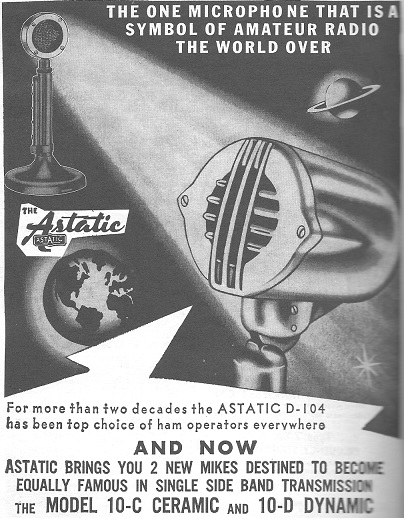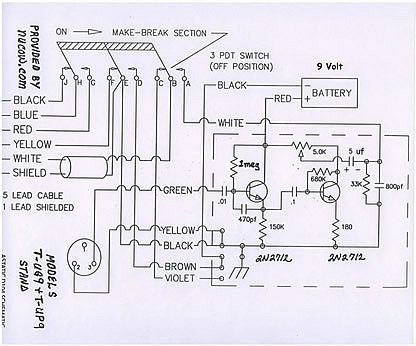

The D104
The old Astatic D-104 microphones work well with vacuum tube boat anchors. The reason for this is that the D104 matches the microphone input impedance of these older rigs. The D104 has an impedance of 500k to 4.7 meg-ohms. Most Vintage transmitters require these high impedance microphones to operate properly.
In turn the D104 also likes to see a high impedance. Below you will find a few interesting Links and articles on the D104. I have repaired a number of these microphones over the years and I have included a few simple tricks and an inexpensive mic element replacement for your review.
The Kobitone Crystal Cartridge , Mouser PN25LM024 is No Longer Available.
However you can get the Kobitone 25LM022 element from
http://rbmicro.com/mic-elements.html for 10 dollars.
The Astatic Story
The following is from the 1946 Astatic Catalogue.
Away back in 1930, two radio amateurs, C. M. Chorpening, W8WR (now W8MJM), and F. H. Woodworth, W8AHW, both of Youngstown Ohio, began searching for a better microphone for their phone transmitters. Up until this time they had been using various carbon type microphones.
The condenser type appealed to them as an answer to their problem. Several units were designed and given trials on the air. Before long, other amateurs among their acquaintance began visiting their shacks, interested in either building or buying this new type of "mike."
Chorpening and Woodworth, encouraged by this interest, decided to form a partnership and build these units for their friends. While the condenser unit proved reasonably satisfactory, it had certain limitations which it was hoped could eventually be overcome.
It was about this time that an old acquaintance, Mr. Charles E. Semple of Cleveland, who had been visiting his "ham" friends frequently, invited them to pay him a visit. With a background of phonograph and loud speaker experience, Mr Semple was then occupying bench space in the Brush Laboratories, experimenting with elements made from Rochelle Salts, (Sodium Potassium Tartrate). Through Mr. Semple, the two visitors met A. L. Williams, electrical and mechanical engineer, and Dr. C. B Sawyer, scientist, who demonstrated the action of these new elements in relation to microphones, phonograph pickups, speakers, recording heads, earphones and other devices where it was desired to transform mechanical energy into electrical energy or the reverse. Here, it seemed, they had found the answer to a simple, low-cost, dependable "mike" for the "ham rig."

Improving the audio response of the amplified D104
The Astatic D104 microphone has a sharp tinny sound due to its crystal cartridge and the preamp in the base of the microphone doesn't help. In most cases this old microphone sounds good when used with the high impeadance input of the boat anchor vintage radios, but not as good as it could. It seems to be missing a lot of the low frequencies. Here are a few things you can try to improve the base response of the D104. First add a 27K-33K resistor between the green wire and the audio amplifier board. Keep the leads short. Next change out 3 coupling capacitors. The .01, the .1 and the 5ufd caps should be replaced. Change them as follows. The .01ufd is replaced with a .22ufd. The 0.1ufd is changed to an electrolytic type 4.7ufd. Connect the plus end of the 4.7 ufd to the base of the second transistor. Lastly change the 5ufd to a 1 ufd. That should help the low frequency response.
Another approach to modifing the D104 is described in an article by N9WB.